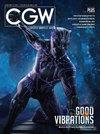Pattern mapping with quad-pattern-coverable quad-meshes
Q4 Computer Science
引用次数: 11
Abstract
Pattern mapping (i.e. texturing arbitrary surfaces with repetitive patterns [Soler et al. 2002]) is a particularly useful texture mapping technique, since repeating a pattern reduces the memory cost, by mapping the same texture image to all faces. Moreover, pattern mapping does not require painting a texture image for each surface or generating a global texture map on each surface. Pattern mapping can potentially provide natural-looking materials, such as stone, wood, or marble, as well as human-made materials, such as wallpapers or repeating tiles. One of the main challenges arising when mapping patterns to arbitrary polyhedral meshes is to avoid texture discontinuities caused by singularities non-4-valent vertices in the quad-meshes. These discontinuities can appear at seams along the edges, which can be visually distracting. Unfortunately, it is not always possible to avoid non-4-valent vertices, since 4-regular quadmeshes exist only for genus-1 surfaces.具有四模式可覆盖四网格的模式映射
模式映射(即用重复的模式对任意表面进行纹理处理[Soler et al. 2002])是一种特别有用的纹理映射技术,因为通过将相同的纹理图像映射到所有的面,重复的模式可以减少内存成本。此外,模式映射不需要为每个表面绘制纹理图像或在每个表面上生成全局纹理映射。模式映射可以潜在地提供看起来很自然的材料,比如石头、木材或大理石,以及人造材料,比如壁纸或重复的瓷砖。将图案映射到任意多面体网格时面临的主要挑战之一是避免由四面体网格中的奇异非4价顶点引起的纹理不连续。这些不连续性可以出现在沿边缘的接缝处,这可能会分散视觉上的注意力。不幸的是,不可能总是避免非4价顶点,因为4规则四边形只存在于属1表面。
本文章由计算机程序翻译,如有差异,请以英文原文为准。
求助全文
约1分钟内获得全文
求助全文

 求助内容:
求助内容: 应助结果提醒方式:
应助结果提醒方式:


